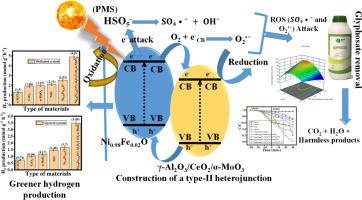Peroxymonosulfate activation by Ni0.98Fe0.02O-loaded γ-Al2O3/CeO2/α-MoO3 type-II heterojunction for photocatalytic glyphosate degradation and hydrogen generation
IF 6.3
3区 工程技术
Q1 ENGINEERING, CHEMICAL
Journal of the Taiwan Institute of Chemical Engineers
Pub Date : 2025-10-09
DOI:10.1016/j.jtice.2025.106451
引用次数: 0
Abstract
Background
Glyphosate contamination in aquatic systems presents severe environmental and health risks, demanding efficient and sustainable removal technologies. Photocatalytic degradation, particularly under visible light, is a promising route. In this study, a green-synthesized type-II nano-heterojunction photocatalyst was developed using Oxystelma esculentum extract. The composite integrates Ni0.98Fe0.02O with γ-Al2O3/CeO2/α-MoO3 to exploit enhanced interfacial charge transfer and reactive oxygen species (ROS) generation for effective glyphosate degradation and hydrogen evolution.
Results
Comprehensive characterization (XRD, XPS, FTIR, SEM/TEM, AFM, and EIS) confirmed the material’s crystallinity, porosity, and strong heterojunction formation. Under visible-light irradiation and peroxymonosulfate (PMS) activation, the catalyst achieved 98.9 % glyphosate degradation in 30 min, with a rate constant of 0.059 min⁻¹, outperforming its individual components. Reactive species quenching identified O₂•⁻ and SO₄•⁻ as primary degradation agents. The catalyst retained 91.6 % efficiency over 10 reused cycles, indicating strong stability. Additionally, it exhibited a high hydrogen evolution rate of 4.9 mmol g⁻¹ h⁻¹. Central Composite Design (CCD)-based Response Surface Methodology (RSM) was employed to optimize operational parameters. The quadratic model (R² = 0.83) effectively predicted system behavior, with optimal values: catalyst dose (0.55 g L⁻¹), pH (9), glyphosate concentration (80 mgL−1), and agitation speed (90 RPM).
Conclusions
This eco-friendly, biologically assisted photocatalyst provides a dual-function platform for the simultaneous removal of glyphosate and photocatalytic hydrogen production. Its high activity, reusability, and scalable synthesis route present it as a promising candidate for sustainable environmental remediation and energy generation.

负载ni0.98 fe0.020的γ-Al2O3/CeO2/α-MoO3型异质结活化过氧单硫酸盐光催化草甘膦降解和制氢
水生系统中的草甘膦污染具有严重的环境和健康风险,需要高效和可持续的去除技术。光催化降解,特别是在可见光下,是一种很有前途的途径。本研究以牛蒡提取物为原料,制备了一种绿色合成的ii型纳米异质结光催化剂。该复合材料将Ni0.98Fe0.02O与γ-Al2O3/CeO2/α-MoO3相结合,利用增强的界面电荷转移和活性氧(ROS)的生成,有效地降解草甘膦和析氢。结果综合表征(XRD, XPS, FTIR, SEM/TEM, AFM和EIS)证实了材料的结晶度,孔隙度和强异质结形成。在可见光照射和过氧单硫酸盐(PMS)活化下,该催化剂在30分钟内实现了98.9%的草甘膦降解,其速率常数为0.059分钟- 1,优于其单个组分。反应物质猝灭确定O₂•毒血症和SO₄•毒血症是主要的降解剂。在重复使用10次后,催化剂的效率保持在91.6%,表明了较强的稳定性。此外,它还显示出4.9 mmol g⁻¹h⁻的高释氢速率。采用基于中心复合设计(CCD)的响应面法(RSM)对运行参数进行优化。二次模型(R²= 0.83)有效地预测了系统的行为,最佳值为催化剂剂量(0.55 gL -¹),pH(9),草甘膦浓度(80 mgL−1)和搅拌速度(90 RPM)。结论该生态友好型生物辅助光催化剂为同时去除草甘膦和光催化制氢提供了双重功能平台。其高活性、可重复利用和可扩展的合成路线使其成为可持续环境修复和能源生产的有前途的候选物。
本文章由计算机程序翻译,如有差异,请以英文原文为准。
求助全文
约1分钟内获得全文
求助全文
来源期刊
CiteScore
9.10
自引率
14.00%
发文量
362
审稿时长
35 days
期刊介绍:
Journal of the Taiwan Institute of Chemical Engineers (formerly known as Journal of the Chinese Institute of Chemical Engineers) publishes original works, from fundamental principles to practical applications, in the broad field of chemical engineering with special focus on three aspects: Chemical and Biomolecular Science and Technology, Energy and Environmental Science and Technology, and Materials Science and Technology. Authors should choose for their manuscript an appropriate aspect section and a few related classifications when submitting to the journal online.

 求助内容:
求助内容: 应助结果提醒方式:
应助结果提醒方式:


